Kerala Plus One Economics Chapter Wise Questions and Answers Chapter 15 Measures of Central Tendency
Plus One Economics Measures of Central Tendency One Mark Questions and Answers
Question 1.
The midpoint of the class ‘5-10’ is:
(i) 5
(ii) 7.5
(iii) 10
(iv) 15
Answer:
(ii) 7.5
Question 2.
Mode is equal to:
(i) 3 median – 2 mean
(ii) 2 median – 3 mea
(iii) 3 median – 3 mean
(iv) 3 median -1 mean
Answer:
(i) 3 median – 2 mean
Question 3.
Which of the following is a positional average?
(i) Mean
(ii) Median
(iii) Mode
(iv) All the above
Answer:
(ii) Median
Question 4.
Which of the following divides the data into four equal parts?
(i) decile
(ii) percentile
(iii) quartiles
(iv) none of the above
Answer:
(iii) quartiles
Question 5.
Which of the following is the most commonly used average?
(i) Arithmetic Mean
(ii) Median
(iii) Mode
(iv) Percentile
Answer:
(i) Arithmetic Mean
Question 6.
Mode can be graphically located by means of
(i) bio diagram
(ii) pie diagram
(iii) histogram
(iv) ogive
Answer:
(iii) histogram
Question 7.
The most suitable average for qualitative measurement is
(i) Arithmetic mean
(ii) Median
(iii) Mode
(iv) Geometric mean
(v) None of the above
Answer:
(ii) Median
Question 8.
Which average is affected most by the presence of extreme items?
(i) median
(ii) Mode
(iii) Arithmetic mean
(iv) Geometric mean
(v) Harmonic mean
Answer:
(iii) Arithmetic mean
Question 9.
The algebraic sum of deviation of a set of n values from A.M. is
(i) n
(ii) 0
(iii) 1
(iv) None of the above
Answer:
(ii) 0
Question 10.
The average value of a given variable is known as ____
Answer:
A.M
Question 11.
Total of given variables can be depicted by _____
Answer:
Σx
Question 12.
Common factor is depicted by ____
Answer:
‘c’
Question 13.
A.M should be
(i) Simple
(ii) Based on all items
(iii) Rigidly defined
(iv) All the above
Answer:
(iv) All the above
Question 14.
Median is the _____ value in a series.
Answer:
Middle.
Question 15.
Q3 represents ____ Quartile.
Answer:
Middle.
Question 16.
_____ is the division of the series into 100 equal parts.
Answer:
Percentiles.
Question 17.
\(\left(\frac{N+1}{10}\right)^{t h}\) is used to calculate _____.
Answer:
Deciles
Question 18.
Value of median is equal to _____Answer:
Answer:
II Quartile – 50th percentile, 5th Decile
Question 19.
Pick out the odd one out and Justify.
Arithmetic mean, Median, Standard deviation, Mode
Answer:
Standard deviation. Others are measures of central tendency.
Question 20.
Which average would be suitable in the following cases?
- Average size of readymade garments.
- Average intelligence of students in a class.
- Average production in a factory per shift.
- Average wages in an industrial concern.
- When the sum of absolute deviations from average is least.
- When quantities of the variable are in ratios.
- In case of open-ended frequency distribution.
Answer:
- Mode
- Median
- Mode or median
- Mode or median
- Mean
- Mode or mean
- Median
Plus One Economics Measures of Central Tendency Two Mark Questions and Answers
Question 1.
Name the types of positional averages.
Answer:
Positional averages are median and mode.
Question 2.
Explain weighted Arithmetic mean
Answer:
When calculating Arithmetic means it is important to assign weights to various items according to their importance. The arithmetic mean calculated with the relative importance to different items is known as weighted arithmetic mean.
Question 3.
Give the special features of arithmetic mean.
Answer:
It is interesting to know and useful for checking your calculation that the sum of deviations of items about arithmetic mean is always equal to zero. Symbolically, S (X-X) = 0.However, arithmetic mean is affected by extreme values. Any large value, on either end, can push it up or down.
Question 4.
If median and mean of distribution are respectively 18.8 and 20.2. What would be its made?
Answer:
Mode = 3 Median – 2 Mean
= 3 × 18.8 – 2 × 20.2
= 56.4 – 40.4 = 16
Question 5.
Mention two demerits of median.
Answer:
- Median is not based on all observations
- It cannot be given for further mathematical treatment
Question 6.
Give the formulae of median in all series
Answer:
Formulae of Median

Question 7.
If median is 15 and mean is 17, calculate mode?
Answer:
Mode = 3 median – 2 mean
= 3 × 15 – 2 × 17
= 45 – 34 = 11
Question 8.
Can there be a situation where mean, median and mode are equal?
Answer:
Yes. Mean, median and mode will be equal when all given variables are the same.
Question 9.
Mark the missing value of the following data. The mean marks are 10.05.
5, 6, 7, 8, 12, ?, 15, 17, 18, 3, 10 5, 10, 12, 15, 11, 13, 1
Answer:
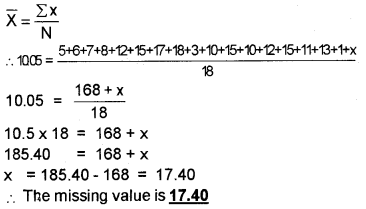
Plus One Economics Measures of Central Tendency Three Mark Questions and Answers
Question 1.
What is the relative position of arithmetic mean, median and mode?
Answer:
Relative position of arithmetic mean, median and mode can be understood from the following narration. Suppose we express,
Arithmetic Mean = Me
Median = Mi
Mode = Mo
The relative magnitude of the three is
Me>Mi>Moor
Me<Mi<Mo
That is the median is always between the arithmetic mean and the mode.
Question 2.
Write down the advantages of median.
Answer:
Merits of median:
- It is easy to understand
- It is not affected by extreme values It can be graphically determined
- It is suitable in case of open-end classes
- It is suitable for qualitative measurement
Question 3.
Write the merits of mode.
Answer:
Merits of mode
- It is easy to understand and simple to calculate
- It is not affected by extreme values
- It can be graphically determined
- It is suitable in case of open-end classes.
Question 4.
Complete the following
- ………………. divides the series into two equal parts
- The central tendency based on all values is …………..
- The average which can be determined through ogive is ………
Answer:
- median
- mean
- median
Question 5.
The mean mark of 60 students in section A are 40 and mean mark if 40 student in section B is 35. Calculate the combined mean of all the students.
Answer:
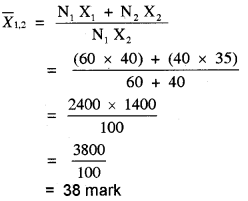
Plus One Economics Measures of Central Tendency Four Mark Questions and Answers
Question 1.
Point out important features of a good average.
Answer:
The important features of a good average are given below.
- It should be easy to understand
- It should be simple to calculate
- It should be rigidly defined
- It should be based on all observations
- It should not be affected by extreme values.
- It should be capable for further statistical calculations.
Question 2.
Following information pertains to the daily income of 150 families. Calculate the arithmetic mean.

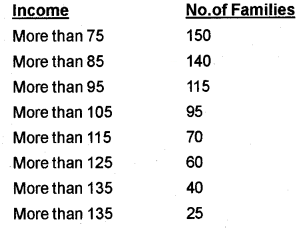
Answer:
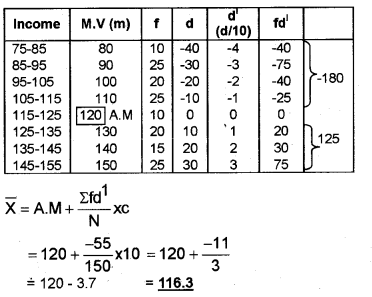
Question 3.
Calculate the median from the following data.
| X | F |
| 0-10 | 5 |
| 10-20 | 8 |
| 20-30 | 10 |
| 30-40 | 14 |
| 40-50 | 3 |
Answer:
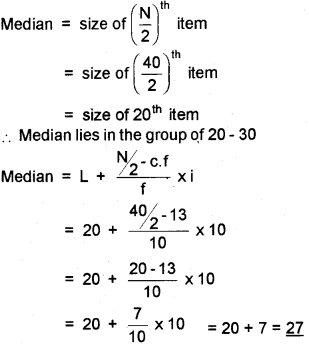
Plus One Economics Measures of Central Tendency Five Mark Questions and Answers
Question 1.
Comment whether the following statements are true or false.
- The sum of deviation of items from median is zero.
- An average alone is not enough to compare series.
- Arithmetic mean is a positional value.
- The upper quartile is the lowest value of top 25% of items.
- Median is unduly affected by extreme observations.
Answer:
- False
- True
- False
- True
- False
Question 2.
There are three types of averages. Name them. Also, give appropriate definitions.
Answer:
There are several statistical measures of central tendency or “averages”. The three most commonly used averages are:
- Arithmetic Mean
- Median
- Mode
1. Arithmetic mean:
Arithmetic mean is the most commonly used measure of central tendency. It is defined as the sum of the values of all observations divided by the number of observations
2. Median:
Median is that positional value of the variable which divides the distribution into two equal parts, one part comprises all values greater than or equal to the median value and the other comprises all values less than or equal to it. The Median is the “middle” element when the data set is arranged in order of the magnitude.
3. Mode:
The word mode has been derived from the French word “la Mode” which signifies the most fashionable values of distribution because it is repeated the highest number of times in the series. Mode is the most frequently observed data value. It is denoted by Mo.
Question 3.
What are the merits and demerits of arithmetic mean?
Answer:
1. Merits
- It is simple to calculate
- It is regidly defined
- It is easy to understand
- It is based on all observations
2. Demerits
- It is affected by extreme values.
- It cannot be calculated in open-end series.
- It cannot be determined graphically.
- It may sometimes give misleading results.
Plus One Economics Measures of Central Tendency Eight Mark Questions and Answers
Question 1.
Prepare a list of peculiarities of median, quartiles, and percentiles.
Answer:
1. Median
- The arithmetic mean is affected by the presence of extreme values in the data.
- If you take a measure of central tendency which is based on middle position of the data, it is not affected by extreme items.
- Median is that positional value of the variable which divides the distribution into two equal parts, one part comprises all values greater than or equal to the median value and the other comprises all values less than or equal to it.
- The Median is the middle element when the data set is arranged in order of the magnitude.
2. Quartiles
- Quartiles are the measures that divide the data into four equal parts; each portion contains equal number of observations. Thus, there are three quartiles.
- The first Quartile (denoted by Q1) or lower quartile has 25% of the items of the distribution below it and 75% of the items are greater than it.
- The second Quartile (denoted by Q2) or median has 50% of items below it and 50% of the observations above it.
- The third Quartile (denoted by Q3) or upper Quartile has75% of the items of the distribution below it and 25% of the items above it.
- Thus, Q1 and Q3 denote the two limits within which central 50% of the data lies.
3. Percentiles
- Percentiles divide the distribution into hundred equal parts, so you can get 99 dividing positions denoted by P1 P2, P3, ………., P99.
- P50 is the median value.
- If you have secured 82 percentile in a management entrance examination, it means that your position is below 18 percent of total candidates appeared in the examination.
Question 2.
The daily sales of car of 20 distributing companies is given below. Calculate:
- Median, upper quartile and lower quartile.
- Interpret the result obtained.
| Daily Sales | No. of Companies |
| 0-20 | 1 |
| 20-40 | 3 |
| 40-60 | 9 |
| 60-80 | 5 |
| 80-100 | 2 |
| 20 |
Answer:
1.
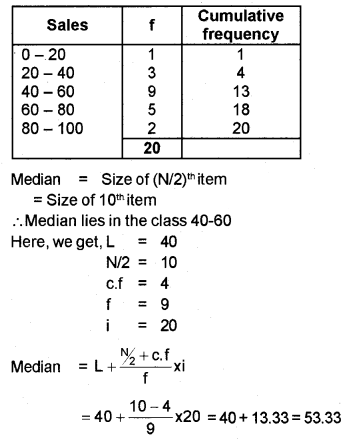

![]()
2. The median divides the values into two equal parts. Lower quartile (Q1) divides the values into 1/4 and upper quartile (Q3) divides the values into 3/4.
